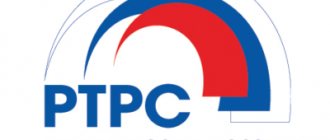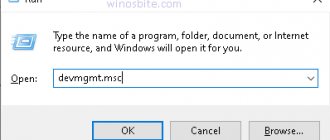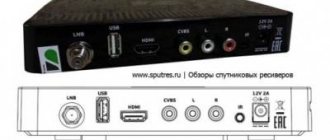Russia will abandon analogue television in January
Subscribe and read Express Newspaper in:
From January 2021, Russia will finally switch to digital TV . As previously reported by the Ministry of Telecom and Mass Communications, Russians will receive 20 mandatory publicly accessible television and three radio channels. They will be free.
EG.RU spoke with the President of the National Association of Television and Radio Broadcasters Eduard Sagalayev about how the transition to digital will be carried out and whether slow-witted citizens will be left without their usual television programs on New Year’s Eve .
Attention to the screen!
The letter A on the TV screen warns you that you are using an old-style TV or have not yet switched the new TV to digital signal reception mode.
“A well-thought-out set of measures is being implemented to inform the population - one of the brightest moments is related to the fact that the letter A has now appeared on the screens of analogue receivers. “Channel One - A”, “RTR - A”. This means that there is analog reception - for people this is a very good guide. In addition, all broadcast channels are talking about the need to switch to digital television,”
— said Eduard Sagalayev.
What will make the picture better?
The picture quality will be provided by the DVB-T2 digital standard. Currently, this is the best signal generation option among the standards widely used in the world.
If an analog signal comes as a continuous wave, which causes interference, then a digital signal “cuts” the usual wave into many small parts, which make it possible to almost completely eliminate interference from the airwaves - they are simply filtered by a special program. Therefore, with the transition to digital, you can forget about picture distortion on TV.
The reliable reception area of DVB-T2 is 10-15 percent larger compared to DVB-T1, which Russia initially wanted to switch to.
What do you need to do to switch to digital?
- The DVB-T2 standard has been adopted as the main format for digital terrestrial TV in Russia. Look in the instructions - can your TV receive a digital signal? Modern models have a built-in digital tuner that supports the DVB-T2 standard, MPEG-4 video coding format and Multiple PLP mode.
- If you still have an old TV model, then you can buy a set-top box at any store that sells digital equipment. The prices are quite affordable - from about 400 rubles. The store salesperson will tell you how to connect it.
- If you are not connected to a collective UHF antenna, then you will have to purchase an individual one. It can be either indoor or outdoor. It all depends on how far you are from the TV tower.
“For more than 10 years now, stores have not sold televisions without the ability to watch digital television. The DVB-T2 format is supported by all new generation models. Anyone who does not want to part with an old analog TV will be able to buy a set-top box - the price of this set-top box is rapidly decreasing, and there is a huge selection in stores. There is evidence that after the transition to digital TV, approximately 90% of Russians will be able to watch the first multiplex and 96.5% will be able to watch the second multiplex. For those who will not have the opportunity to watch terrestrial television, measures are in place - viewers will have the opportunity to watch cable and satellite television for free. Satellite operators will broadcast programs from two multiplexes for free,”
- added Eduard Sagalayev.
Has no analogue: what will the transition to digital TV bring to Russians?
Russia's transition to digital television took place over 10 years and cost 200 billion rubles. Citizens will eventually receive free TV with high picture quality, which previously only subscribers of paid channels could afford. The pilot launch took place in the Tver region and was considered successful. All remaining regions must switch to digital by June 3. As Izvestia found out, for complete digitalization, citizens and regional budgets will have to invest about 1 billion rubles more, and it will cost regional television companies 30–35 million rubles a year. At the same time, the federal budget will be able to receive from 50 to 250 billion rubles through the sale of freed frequencies to commercial companies.
Voice of numbers: the new State Duma will be elected by “mobile voters”
Ella Pamfilova reported to Vladimir Putin on the Central Election Commission’s plans to use modern technologies
Ether sample
The official transition to digital in Russia began on January 1, 2019. But in fact, a gradual phase-out of analogue broadcasting is planned. From February 11, Chechnya, Magadan, Penza, Ryazan, Tula, Ulyanovsk and Yaroslavl regions will be disconnected from it. From April 15 - Moscow, Moscow region, Amur region, Yamalo-Nenets Autonomous Okrug and 16 other regions, and from June 3 - the remaining constituent entities of the Russian Federation, including St. Petersburg.
The first pilot region was the Tver region, where broadcasting was carried out exclusively digitally from the beginning of December. The experiment was successful, according to the Ministry of Telecom and Mass Communications.
— There have been no changes in the structure and volume of television viewing. The population did not have any problems. The volunteers worked well, the staff of the consultation hotlines answered all questions in a timely manner,” Deputy Minister of Digital Development, Communications and Mass Communications Alexey Volin told Izvestia.
The region has allocated subsidies of up to 1 thousand rubles for the purchase of equipment for low-income families and pensioners.
Also, local authorities and antimonopoly authorities ensured that retailers did not inflate prices for TV set-top boxes. The growth stopped after the FAS in December opened cases against the DNS, M.Video, Eldorado and Yulmart networks.
Author of the quote
What is the difference between digital TV and regular TV?
Digital television allows you to transmit more information at lower costs for frequency resources. It becomes possible to broadcast several TV channels on one frequency and connect additional options, such as voting or teletext. Digital broadcasting is not afraid of interference - such a signal creates an ideal picture. As an analogy, experts cite an old rotary telephone and a modern smartphone, with which you can not only make calls, but also communicate on social networks, watch movies and make online orders. The only negative is that digital requires a total upgrade of equipment: transmitting and receiving.
Digital terrestrial television will bring the audience a set of 20 channels, formed into two packages (multiplex). Previously, this quality was available only to subscribers of cable operators; now it will be free for everyone. The first multiplex includes Channel One, Rossiya 1, Match TV, NTV, Channel 5, Rossiya-Kultura, Rossiya 24, Karusel, OTR, TV Center. In the second - REN TV, Spas, STS, Domashny, TV3, Friday, Zvezda, Mir, TNT and MuzTV.
"Digital" without any complaints
Vladimir Putin noted the experience of the Tver region in the transition to new television broadcasting technology
Who pays
The thorny path to digital for Russia began in 2009, when the Federal Target Program (FTP) for the development of television and radio broadcasting in the country until 2021 was adopted. By that time, in most leading European countries (Great Britain, Germany, France, Italy and others), the transition to a digital signal transmission format had already occurred or was in its final stages.
In Russia, this took ten years and 174 billion rubles, of which the state invested 97 billion rubles, the rest from private companies in the telecommunications sector. As follows from the Federal Target Program, another 30 billion rubles will be spent directly during the transition period. That is, the digital revolution, at a cost of 204 billion rubles, was paid for by large businesses and partly by the population through taxes.
Regional television companies were formally allowed to maintain analogue broadcasting until August 2021. However, some of them have already approached the government with a request to include them in one of the digital packages. Viewers clearly will not waste time constantly switching from analogue to digital, explained the Novosibirsk Regional Television and Radio Broadcasting Network (OTN). The Ministry of Telecom and Mass Communications told Izvestia that “the possibilities of digital broadcasting of regional TV channels as part of the first multiplex” are being studied. The costs of regional channels in this case are estimated at 30–35 million rubles per year. Thus, small television companies in the constituent entities of the Russian Federation will also have to invest in the digital future.
Who needs it
We caught the signal: from 2021, analog TV will be a thing of the past
How exactly will the transition to digital television be accomplished?
In addition to high-quality, noise-free images, digital has other advantages. The frequencies occupied today by analogue broadcasting can be used more efficiently, Konstantin Lyalin, deputy director of the Institute of Microdevices and Control Systems of the National Research University MIET, explained to Izvestia.
— We have an extremely dense frequency resource. If you remove analogue broadcasting, the range will be freed up, which can be used to transmit, for example, the Internet of Things,” he said.
A limited number of frequencies, a significant part of which is traditionally allocated to the military, prevented the emergence of fourth (4G) and fifth generation (5G) networks in Russia, added TelecomDaily CEO Denis Kuskov.
According to Internet Ombudsman Dmitry Marinichev, the switch to digital format should have been “at least four to five years ago.” We must keep up with the times and synchronize technological changes with the international community, in this case with the European Union, the expert emphasized.
In Russia, frequencies are distributed by the state. Commercial structures pay rent. According to estimates by the head of the department of telecommunication systems at the Moscow Institute of Electronic Technology, Alexander Bakhtin, after the deployment of digital broadcasting, up to 50% of frequencies may be freed up, which will significantly replenish the treasury at the expense of funds from the commercial sector (cellular operators, television and radio companies). Frequencies are a non-renewable resource for which the state receives a lot of money, the expert summarizes. He found it difficult to estimate his income. Leading analyst of Mobile Research group Eldar Murtazin says that the state can receive a minimum of 50-60 billion rubles, the upper limit is 250 billion.
A remote village in Kamchatka connected to the Internet
— Approximately a third of the frequencies released today will be sold to private companies, or rather, rented out for long-term lease for a period of 10 years or more. The total cost will depend on the parameters of the auction, the allocation of frequencies, and how quickly the frequencies will be played out,” the expert explained.
The ultimate beneficiaries of the transition to digital, in his opinion, are the audience and the state. For example, citizens will receive free television with high picture quality, which previously only subscribers of paid channels could afford. The benefit of cellular operators and broadcasters will be indirect - due to improved quality of services provided.
Everyone will be connected
After June 3, analogue signal transmission will cease throughout the country. Owners of old and some models of relatively new televisions who did not have time to purchase set-top boxes may be left without their favorite programs. But there are relatively few such people: according to the Ministry of Telecom and Mass Communications - about 1.2 million people (less than 1% of the population), according to the TelecomDaily agency - about 5 million, taking into account the remoteness of RTRS antennas and the lack of suitable television receivers.
Author of the quote
How to switch to digital:
A special set-top box-decoder will be needed for those whose TV is not capable of receiving a digital signal of the DVB-T2 standard and the MPEG4 video format. This is not necessarily an old technique, the question is whether it can work with this particular signal encoding. The cost of consoles starts from 700 rubles. Residents of remote villages not covered by broadcasting (less than 2% of the territory of the Russian Federation) will have to purchase a complete set of equipment for 6 thousand rubles.
The Tver experience of helping the population will be replicated in other regions. The budget of the Sverdlovsk region has already allocated 140 million rubles to help the poor in purchasing digital equipment, in the Chelyabinsk region - 307 million, in the Primorsky Territory they plan to issue 6 thousand rubles for the purchase of a satellite TV set. Households that are not included in the state assistance program will pay for the transition to digital broadcasting from their own pockets.
Minimum prices for digital TVs in Russia announced
The Ministry of Telecom and Mass Communications estimates the need for equipment for the regions of the first stage of shutdown at 200 thousand sets, the second stage - about 1.2 million. Thus, if we proceed from the minimum price of 700 rubles per set, the costs will be at least 980 million rubles.
Analogue broadcasting will not stop suddenly - in all regions the transition to digital is accompanied by preparatory work. If the letter “A” appears on the screen next to the channel logo, it means that the TV is receiving an analog signal: it’s time to think about changing the settings or purchasing a set-top box. If the letter “A” is not on the screen, you don’t need to do anything. For example, in Moscow, residents of a house often watch TV from a common antenna. In this case, all the necessary settings were made by the operator company. Satellite TV subscribers also receive a digital signal. For them and the owners of most relatively new TVs (released after 2012), the transition will go unnoticed.
What will happen to regional television?
This is the problem, says the expert. Regional television is not included in these two multiplex packages, and the National Association of Television and Radio Broadcasters has been trying for years to have another multiplex organized specifically for regionals.
“At the same time, the state does not need to invest any funds, because regional TV channels are able to buy their own transmitter and provide a frequency for broadcasting another, regional, multiplex. Often, regional television is even ahead of federal television - now is the time for change, the search for new technologies, new ways,”
— said Eduard Salagaev, emphasizing that in the regions it will also be possible to watch local television, since large cities have long been enveloped in cable networks.
What if there is no way to replace the old TV?
You can buy a set-top box for an analog TV and a decimeter antenna. The set-top box converts a digital signal and makes it possible to watch 20 publicly available federal channels for free.
You can order a set-top box both in the online store and at the Russian Post office (the price of the set-top box in the postal catalog is from 1200 to 2500 rubles).
The government has instructed regional authorities to provide targeted assistance to socially vulnerable residents of the regions for the purchase of antennas and set-top boxes.
Specifically
How to set up channels
To set up digital broadcasting channels, you need to perform a certain algorithm of actions. However, it does not depend on the type of equipment used. This can be either a new generation TV or a set-top box. Users have access to settings in automatic or manual mode. Next, we will consider each of them in more detail.
Automatic setup
Setting up television channels in digital mode depends on the type of equipment used. If you are using a newer generation TV that is capable of operating in the DVB T2 format, then you will need to go to the setup menu. There you need to find the automatic configuration item and start the process.
When using a set-top box, the process for setting up channels will be similar. The difference will be that you will need to look for the automatic setup item in the menu. After searching for television channels, as a rule, the digital set-top box saves them automatically. But in rare cases, you may need to save the found channels yourself.
There is also a function for user-friendly channel ordering. If you wish, you can assign them names and group them yourself. The setup process is quite simple. The receiver menu is almost identical to the TV. It becomes clear on an intuitive level.
Manual channel tuning
The process of manually tuning television channels is carried out similarly to the previous paragraph. But at the same time, the user will need to know what waves the digital signals are broadcast on. They must be entered manually to perform a search. For each region, data on digital signal broadcast waves is different.
When setting up channels via a set-top box, you may also need to select your country of residence, menu language and image format.
Digital TV channels
Let's consider how many channels will be available for viewing. Free digital television includes access to two multiplexes. Each of them consists of 10 free channels. Three radio waves will also be available. At the same time, residents of Russia will have access to one multiplex.
Work is underway in individual regions on access to the list of channels in the second package. Therefore, the timing of access to them may vary. At the same time, experts note that the quality of television pictures will correspond to the level of cable television, which was used by many citizens in previous years.
Here are the channels that will be on digital television:
MULTIPLEX RTRS-1: “Channel One”, “Russia 1”, “Match TV”, NTV, “Petersburg-5 channel” “Russia K”, “Russia 24”, “Carousel”, etc.
MULTIPLEX RTRS-2: “Friday”, “Spas”, “Domashny”, “Zvezda”, TV3, etc.
A protracted farewell to analog TV
The possibility of using radio frequencies for analogue television broadcasting in Russia has been extended for another year - until August 19, 2021. This decision was made by the State Commission on Radio Frequencies (SCRF), whose meeting today, July 14, 2021, was chaired by the head of the Ministry of Telecom and Mass Communications Maksut Shadayev .
The decision to use frequencies for analogue television broadcasting relates only to existing analogue television transmitters and does not imply the creation of new analogue TV broadcasting networks, it was clarified during the SCRF meeting.
To extend permits for analogue television broadcasting, heads of TV channels must promptly contact Roskomnadzor with a corresponding application before July 20, 2021. The decision to extend the validity of permits will be made by Roskomnadzor in the prescribed manner no later than the end of their validity period.
The SCRF decision to renew licenses for analogue TV specifically emphasizes that such radio-electronic equipment “should not interfere with existing and planned digital broadcasting distribution networks, including high-definition television (HDTV).”
Where to go with questions about digital television, hotline?
If you have terrestrial TV, then you can find all the information about the transition to digital terrestrial television on the website of the Russian television and radio broadcasting network rtrs.rf (aka smotritsitru.rf) or consult with RTRS specialists by calling the hotline.
If you are a cable TV subscriber, contact your operator's support services.
You can also contact the Moscow Unified Information Service by phone. Video instructions on how to switch from analogue television to digital:










